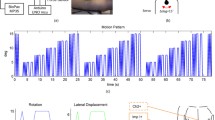Summary
When monitoring bioelectric signals the surface electrodes can cause a retroaction on the subject thereby introducing an error of measurement. There are two types of retroaction: physical and psycho-physiological.
A physical retroaction due to the hydration process of the skin occurs if ‘wet’ electrodes are used for the recording of the skin conductance level (SCL) causing a continuous drift of the SCL and a decrease in sensitivity to SCL changes. Therefore a dry electrode was developed with improved performance: It exhibits less sensitivity to motion, is not subject to polarization, and features better SCL long-term stability.
When recording the electrocardiogram or the electromyogram a psycho-physiological retroaction occurs due to the annoyance caused by the skin-irritating abrading techniques in order to decrease the skin impedance and reduce the motion artifact. In an attempt to abandon the skin preparation whenever permissible without sacrificing the measurement accuracy a performance estimation procedure was developed. Basing on the information on the signal frequency content, the electrode contact area, the required accuracy of measurement and the amplifier input impedance a decision on the necessity of skin preparation is made. Moreover, the results of a study are reported investigating the reduction of motion artifacts by means of electrode design and appropriate electrode jelly formulation.
Zusammenfassung
Bei der Langzeitableitung von bioelektrischen Signalen können Me\fehler infolge einer Rückwirkung der Elektroden auf das Me\objekt entstehen. Es ist eine physikalische von einer psycho-physiologischen Rückwirkung zu trennen.
Eine physikalische Rückwirkung entsteht bei der HautleitfÄhigkeitsmessung (Skin Conductance Level, SCL) mittels ‚feuchter‘ Elektroden infolge einer zunehmenden Hautdurchfeuchtung. Die Folge ist eine kontinuierliche Drift der SCL bei gleichzeitiger Verminderung der Empfindlichkeit gegenüber SCL-Änderungen. Deshalb wurde eine verbesserte ‚trockene‘ Elektrode entwickelt, die eine geringere Bewegungsempfindlichkeit und bessere SCL-StabilitÄt als feuchte Elektroden aufweist sowie unpolarisierbar ist.
Eine psycho-physiologische Rückwirkung entsteht bei EKG- oder EMG-Ableitungen infolge der BelÄstigung durch hautreizende abrasive Behandlungen, deren Zweck die Verminderung der Hautimpedanz und der Bewegungsartefakte ist. Um unnötige HautprÄparationen zu vermeiden, wurde eine Entscheidungshilfe entwickelt, die den Frequenzgehalt des Signals, die ElektrodenkontaktflÄche, die erforderliche Me\genauigkeit und die VerstÄrkereingangsimpedanz berücksichtigt. Darüber hinaus wird über Versuche berichtet, die Bewegungsartefakte durch Elektrodengestaltung oder geeignete Wahl des Kontaktvermittlers zu reduzieren.
Similar content being viewed by others
Literatur
Bergey, G. E., Squires, R. D.: Improved buffer amplifier for incorporation within a biopotential electrode. IEEE Trans. Biomed. Eng. 18, 430–431 (1971)
Blank, I. H., Finesinger, J. E.: Electrical resistance of the skin. Arch. Neurol. Psychiat. 56, 544–557 (1946)
Brown, W. E. L., Hill, A. V.: The production of an electromotive force by the movement of salt solution past silver electrodes. J. Physiol. 54, 109–111 (1920)
Burbank, D. P., Webster, J. G.: Reducing skin potential motion artifact by skin abrasion. Med. Biol. Eng. Comput. 16, 31–38 (1978)
Edelberg, R.: Electrical activity of the skin. In: Handbook of psychophysiology. Greenfield, N., Sternbach, R. (eds.), pp. 367–417. New York: Holt, Rinehart and Winston 1972
Edelberg, R.: Local electrical responses of the skin to deformation. J. Appl. Physiol. 34, 334–340 (1973)
Faber, S.: Methodische Probleme bei Hautwiderstandsmessungen. Biomed. Tech., ErgÄnzungsband 22, 393–394 (1977)
Fowles, D. C.: Mechanisms of electrodermal activity. In: Bioelectric recording techniques, Vol. 1. Thompson, R. F., Patterson, M. M. (eds.), pp. 231–271. New York, London: Academic Press 1974
Geddes, L. A.: Electrodes and the measurement of bioelectric events. New York: Wiley 1972
Geddes, L. A., Baker, L. E., Moore, A. G.: The use of liquid-junction electrodes in the human electrocardiogram (ECG). Electrocardiol. 1, 51–56 (1968)
Geddes, L. A., Bourland, J. D., Smalling, R. W., Steinberg, R. B.: The use of the same pair of dry electrodes to record skin resistance and beat-by-beat heart rate. Med. Biol. Eng. Comput. 13, 89–96 (1975)
Kahn, A.: Motion artifacts and streaming potentials in relation to biological electrodes. Dig. 6th Int. Conf. Med. Elec. Biol. Eng. 562–563 (1965)
Klijn, J. A. J., Kloprogge, M. J. G. M.: Cable artifact suppressor for electrophysiological recording. Electromyogr. Clin. Neurophysiol. 13, 87–92 (1973)
Luczak, H., Rohmert, W.: Anpassungsreaktionen von Arbeitspersonen bei ergonomischen Feldstudien informatorischer Arbeitsinhalte. Eur. J. Appl. Physiol. 35, 33–47 (1976)
Rohmert, W.: Belastung und Beanspruchung von Fluglotsen. Stuttgart: Gentner 1973
Rutenfranz, J.: Zur Frage einer Tagesrhythmik des elektrischen Hautwiderstandes beim Menschen. Int. Z. Angew. Physiol. 16, 152–172 (1955)
Tam, H. W., Webster, J. G.: Minimizing electrode motion artifact by skin abrasion. IEEE Trans. Biomed. Eng. 24, 134–139 (1977)
Zipp, P.: Die Bemessung der Elektroden-Haut-KontaktflÄche und der VerstÄrkereingangsimpedanz bei der quantitativen OberflÄchenelektrographie (EKG und EMG). Biomed. Techn. 23, 130–140 (1978)
Zipp, P., Schad, E.: Quantifizierung der Bewegungsempfindlichkeit von OberflÄchenelektroden. Biomed. Techn. 24, 76–81 (1979)
Author information
Authors and Affiliations
Additional information
Die vorliegende Arbeit wurde durch die finanzielle Förderung der Deutschen Forschungsgemeinschaft im Rahmen des Sonderforschungsbereichs 152 ermöglicht
Herrn Prof. Dr.-Ing. Walter Rohmert zum 50. Geburtstag gewidmet
Rights and permissions
About this article
Cite this article
Zipp, P., Faber, S. Rückwirkungsarme Ableitung bioelektrischer Signale bei arbeitswissenschaftlichen Langzeituntersuchungen am Arbeitsplatz. Europ. J. Appl. Physiol. 42, 105–116 (1979). https://doi.org/10.1007/BF00421909
Accepted:
Issue Date:
DOI: https://doi.org/10.1007/BF00421909




